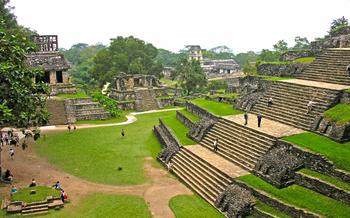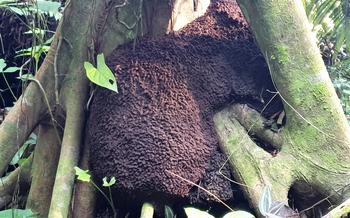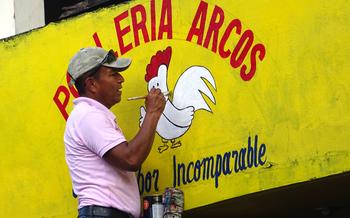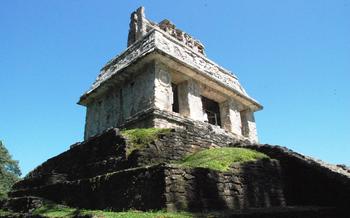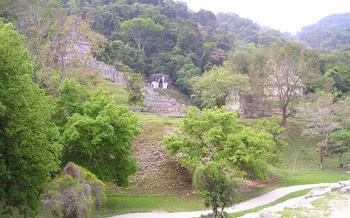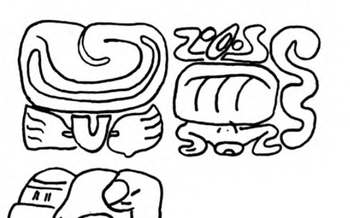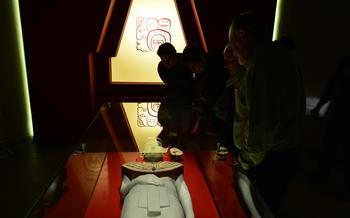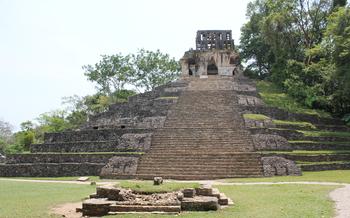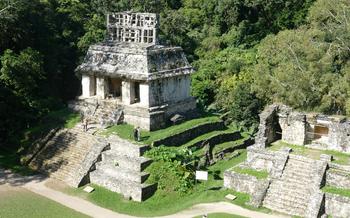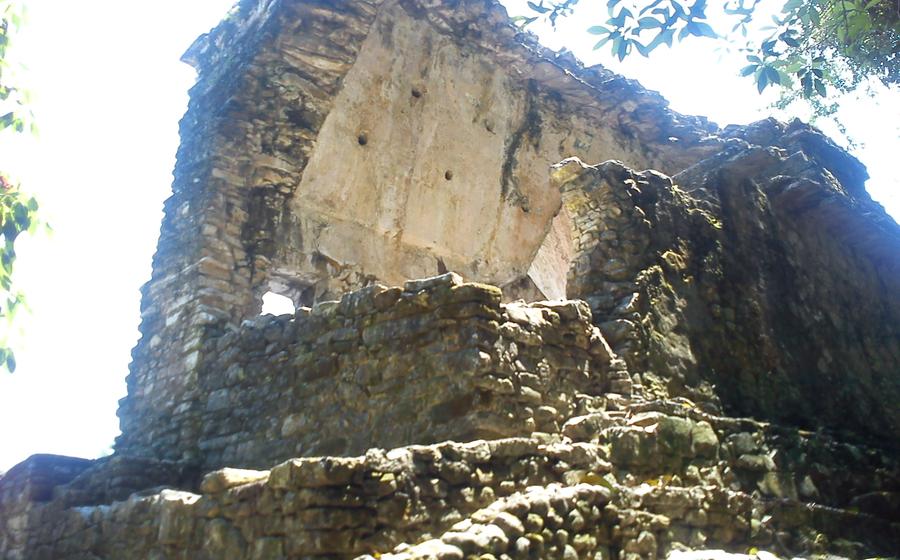
Templo de la Calavera
- The Templo de la Calavera: A Stunning Masterpiece
- Exploring the Temple Grounds
- Immerse in Maya History and Culture
- Unveiling the Temple's Secrets
- Tips for Planning Your Visit
- Transportation Options to Palenque
- Accommodation Options Near the Temple
- Local Cuisine to Try in Palenque
- Other Attractions in Palenque
- Unforgettable Tours and Guides
- Safety Tips for Travelers
- Photography Tips for Stunning Shots
- Responsible Tourism Practices
- Souvenirs and Local Crafts
- Insider Tip: Hidden Gems to Discover
The Templo de la Calavera: A Stunning Masterpiece
The Templo de la Calavera, known for its intricate carvings depicting a human skull, stands as a testament to the architectural brilliance and spiritual beliefs of the ancient Maya civilization. Constructed around 722-729 AD during the reign of King K'inich Janaab' Pakal, this temple is a masterpiece of Maya art and architecture. Its unique features, such as the skull-shaped roof comb, elaborate stucco reliefs, and symbolic imagery, offer a glimpse into the complex religious and cultural world of the Maya people. As one of the most iconic structures in the ancient city of Palenque, the Templo de la Calavera invites visitors to explore the rich history and enduring legacy of this ancient civilization.
Exploring the Temple Grounds
The Templo de la Calavera is situated within a larger temple complex, offering visitors a glimpse into the architectural prowess of the ancient Maya. The complex is designed with a central plaza surrounded by several structures, each serving a specific purpose. Notable among these is the Temple of the Inscriptions, renowned for its intricate carvings and the tomb of the great ruler Pakal the Great. The surrounding plaza, with its meticulously arranged altars and stelae, was likely used for religious ceremonies and public gatherings. Accessibility to the temple complex is well-maintained, with designated pathways and ramps catering to visitors of all abilities. Restrooms and drinking water facilities are available for convenience, ensuring a comfortable and enriching experience for all.
Immerse in Maya History and Culture
The Templo de la Calavera stands as a testament to the rich history and cultural heritage of the ancient Maya civilization. Palenque, where the temple resides, played a significant role in the Maya world, serving as a prominent city-state during the Classic period.
The temple itself held profound religious and ceremonial importance for the Maya. It was dedicated to the revered Maya deity known as K'uk'ulkan, also known as the Feathered Serpent God. Through the temple's elaborate iconography and symbolism, visitors can gain insights into the Maya worldview, their beliefs, and their intricate understanding of the cosmos.
Interactive exhibits and educational resources available at the site further enhance the visitor experience, providing a deeper understanding of Maya history and culture. These exhibits showcase artifacts, replicas, and multimedia presentations that bring the ancient Maya world to life.
Unveiling the Temple's Secrets
The Templo de la Calavera has yielded a wealth of archaeological discoveries, shedding light on the intricate world of the ancient Maya. Excavations have revealed numerous artifacts, including ceramic vessels, jade ornaments, and stone sculptures, providing valuable insights into Maya rituals and daily life. Ongoing research and excavations continue to uncover new secrets, offering glimpses into the beliefs, practices, and history of this enigmatic civilization.
Intriguing theories and interpretations surround the temple's purpose and symbolism. Some scholars believe it served as a mortuary temple, dedicated to honoring the deceased rulers of Palenque. Others suggest it was a place of pilgrimage, where Maya devotees gathered to perform sacred rituals and seek spiritual guidance. The intricate iconography adorning the temple's facade and interior further fuels speculation, offering tantalizing clues to the beliefs and worldview of the ancient Maya.
Despite the extensive research, many mysteries still shroud the Templo de la Calavera, adding to its allure. The exact significance of its elaborate carvings, the nature of the rituals performed within its walls, and the reasons behind its abandonment remain subjects of ongoing debate. These enigmas only deepen the fascination surrounding this ancient masterpiece, inviting visitors to delve into the rich history and culture of the Maya civilization.
Tips for Planning Your Visit
To make the most of your visit to the Templo de la Calavera, it's important to plan ahead. The best time to visit is during the dry season, from November to April, when the weather is pleasant, and there are fewer crowds. Aim to spend at least two to three hours exploring the temple complex, allowing ample time to admire the intricate details and immerse yourself in the history and culture of the Maya. Remember to bring essentials like water, sunscreen, and comfortable shoes, as the temple grounds involve some walking. Accessibility is generally good, with paved paths and ramps, making the site accessible to visitors with disabilities.
Transportation Options to Palenque
Palenque is easily accessible by air, bus, or car, making it a convenient destination for travelers. The nearest airport is Palenque International Airport (PQM), located just outside the city, with flights connecting to major cities in Mexico and Guatemala. Several airlines, including Aeroméxico, Interjet, and Volaris, offer regular flights to Palenque.
If you prefer traveling by land, you can take a bus from major cities such as Mexico City, San Cristóbal de las Casas, and Villahermosa. Bus companies like ADO and OCC offer comfortable and reliable services, with fares ranging from $20 to $50 depending on the distance.
For those who enjoy road trips, driving to Palenque is a scenic and flexible option. The city is well-connected by highways, and the journey from Mexico City takes approximately 10-12 hours. Car rental agencies are available at the airport and in the city, offering a range of vehicles to suit your needs.
Once in Palenque, getting around is relatively easy. The city is compact, and most attractions, including the Templo de la Calavera, are within walking distance of the city center. However, tuk-tuks and taxis are readily available for short distances, with fares starting from $2-
Accommodation Options Near the Temple
Palenque offers a range of accommodation options to suit every budget and preference. Whether you seek luxury, comfort, or affordability, you'll find a place to rest your head near the Templo de la Calavera.
For a truly immersive experience, consider staying at one of the hotels or guesthouses located within walking distance of the temple. This allows you to start your day early and explore the site before the crowds arrive. Hotels like Hotel Maya Tulipanes and Hotel Palenque offer comfortable rooms with modern amenities, while guesthouses like Casa Bakal provide a more intimate and budget-friendly option.
If you prefer a more secluded stay, opt for one of the hotels or resorts situated on the outskirts of Palenque. These properties often offer stunning views of the surrounding rainforest and amenities like swimming pools and spas. Quinta Chanabnal and Hotel Quinta Esmeralda are popular choices for those seeking tranquility and relaxation.
When choosing your accommodation, consider factors like location, amenities, and budget. Remember to book your stay in advance, especially during peak tourist season, to secure the best deals and availability.
Local Cuisine to Try in Palenque
Immerse yourself in the rich culinary traditions of Palenque by savoring the authentic flavors of Maya cuisine. Indulge in the tantalizing aromas and unique ingredients that have been passed down through generations, showcasing the vibrant culinary heritage of the region. From traditional Maya dishes to modern fusion creations, Palenque offers a diverse range of culinary delights.
Don't miss the chance to sample must-try dishes such as tamales, a Mesoamerican staple made from corn dough and filled with savory fillings wrapped in banana leaves. Experience the succulent flavors of poc chuc, a grilled pork dish marinated in a tangy citrus sauce, accompanied by flavorful sides like pickled onions and habanero salsa. Delight in the creamy richness of pipián, a traditional sauce made from ground pumpkin seeds, often served with tender chicken or vegetables.
Venture into the heart of Palenque's local markets to discover an array of street food vendors offering fresh and flavorful snacks. Sample the crispy tortillas filled with savory fillings, or indulge in the smoky goodness of grilled meats and vegetables. For a sweet treat, try the traditional marquesitas, thin crepes filled with sweet fillings like cajeta (caramel sauce) or fresh fruit.
To fully immerse yourself in the local culinary scene, visit the many restaurants in Palenque that celebrate traditional Maya cuisine. Opt for family-run establishments or seek out cooking classes to learn the secrets behind these delicious dishes. Whether you prefer fine dining or casual eateries, Palenque's culinary scene promises an unforgettable gastronomic adventure.
Other Attractions in Palenque
Palenque is not just about the Templo de la Calavera. The region is brimming with other captivating attractions that offer a diverse range of experiences. Just a stone's throw away lies the awe-inspiring Palenque National Park, a UNESCO World Heritage Site. Within its lush embrace, you'll find tumbling waterfalls, verdant rainforests, and a rich tapestry of flora and fauna. Hike through the jungle, spot exotic birds and wildlife, and take a refreshing dip in natural pools.
If you crave more ancient history, explore nearby archaeological sites like Yaxchilán and Bonampak. These hidden gems showcase intricately carved temples, stelae, and vibrant murals that offer a glimpse into the lives of the ancient Maya.
For a cultural immersion, visit the Palenque Archaeological Museum, which houses a vast collection of Maya artifacts, pottery, and sculptures. Learn about the region's rich past and gain a deeper understanding of Maya civilization.
Palenque also serves as a gateway to other captivating destinations. Embark on a day trip to the picturesque Agua Azul Waterfalls, where turquoise waters cascade over limestone cliffs, creating a mesmerizing spectacle. Or venture into the Lacandon Jungle, home to indigenous communities and a mesmerizing array of flora and fauna.
With its wealth of natural and cultural attractions, Palenque offers an unforgettable journey that will leave you spellbound.
Unforgettable Tours and Guides
Exploring the Templo de la Calavera and Palenque with a knowledgeable guide can elevate your experience from ordinary to extraordinary. These experts offer a wealth of insights into the history, culture, and symbolism of the temple, making your visit more meaningful and immersive.
Local guides are passionate storytellers who bring the ancient Maya civilization to life, providing a deeper understanding of their beliefs, rituals, and daily lives. They can point out hidden details and explain the significance of the temple's architecture, iconography, and artifacts.
Choose from various tour options to suit your preferences and budget, including guided visits, private tours, and group tours. Guided visits typically cover the highlights of the temple complex, while private tours offer a more personalized experience with flexible itineraries and in-depth discussions. Group tours are a great way to meet fellow travelers and share the adventure.
To ensure a high-quality experience, research reputable tour operators and guides in Palenque. Look for companies with experienced and certified guides who are passionate about sharing their knowledge. Read online reviews and ask for recommendations from your hotel or hostel.
Hiring a local guide for your visit to the Templo de la Calavera is an investment that will pay off in dividends of knowledge, appreciation, and memories that will last a lifetime.
Safety Tips for Travelers
Palenque is generally a safe destination, but like any tourist destination, it's important to take precautions to ensure a smooth and enjoyable trip. Here are some safety tips to keep in mind:
-
Be aware of your surroundings: Pay attention to your surroundings and be cautious of people who may be trying to distract you or take advantage of you.
-
Avoid walking alone at night: If you must walk at night, stick to well-lit areas and try to travel with a companion.
-
Be careful of your belongings: Keep your valuables close to you and avoid leaving them unattended.
-
Don't flash your cash: Avoid carrying large amounts of cash, and be discreet when using your credit cards.
-
Use trusted transportation: When taking taxis or tour buses, use only those from reputable companies or recommended by your hotel or tour operator.
-
Be respectful of local customs: Dress modestly and avoid offensive behavior or language.
-
Learn a few basic Spanish phrases: Being able to communicate in Spanish can help you avoid misunderstandings and connect with locals.
-
Trust your instincts: If something feels wrong, it probably is. Don't be afraid to walk away from a situation that makes you uncomfortable.
Photography Tips for Stunning Shots
Capturing the beauty of the Templo de la Calavera through photography requires a combination of skill, patience, and technical knowledge. Here are some tips to help you take stunning shots of this ancient masterpiece:
-
Choose the Right Angle: Experiment with different angles to find the most flattering perspective. Shoot from a low angle to emphasize the temple's grandeur, or climb the nearby structures for a bird's-eye view.
-
Consider Lighting Conditions: The best time to photograph the temple is during the golden hours of sunrise and sunset, when the warm light enhances the intricate carvings and textures. Avoid midday sun, which can create harsh shadows and overexposed areas.
-
Use a Tripod for Stability: A tripod is essential for sharp and steady shots, especially when shooting in low-light conditions. It allows you to use slower shutter speeds without camera shake, capturing details that might otherwise be blurred.
-
Focus on the Details: Take your time to capture the intricate details of the temple's carvings and sculptures. Use a macro lens or zoom in to highlight the craftsmanship and symbolism of these ancient artworks.
-
Experiment with Composition: Play with different composition techniques to create visually appealing shots. Use leading lines, symmetry, or foreground elements to draw the viewer's eye towards the temple.
-
Edit and Enhance: Once you've captured your shots, don't forget to edit and enhance them to bring out the best in your images. Adjust colors, contrast, and sharpness to create a cohesive and visually stunning collection of photographs.
Responsible Tourism Practices
As you explore the Templo de la Calavera and Palenque, it is important to be mindful of your impact on the environment and the local community. Here are some responsible tourism practices to follow:
Minimize Waste: Avoid single-use plastics and bring your own reusable water bottle and shopping bags. Dispose of waste properly in designated bins. Support Local Businesses: Choose local restaurants, hotels, and tour operators over large international chains. This helps support the local economy and preserves the unique character of the region. Respect Cultural Traditions: Be respectful of local customs and traditions. Dress appropriately and ask permission before taking photos of people or sacred sites. Protect the Environment: Avoid littering and damaging plants or wildlife. Stay on designated trails and avoid disturbing natural habitats. Leave No Trace: When camping or hiking, leave no trace of your presence. Pack out all trash and minimize your impact on the environment.
Souvenirs and Local Crafts
As you explore the vibrant streets of Palenque, you'll encounter a treasure trove of unique souvenirs and local crafts that reflect the rich cultural heritage of the region. From intricate textiles and colorful pottery to hand-carved wooden sculptures and traditional Maya jewelry, there's something for every taste and budget.
One of the best ways to support local artisans and immerse yourself in the local culture is to visit the bustling markets. Here, you'll find vendors selling an array of handmade goods, from vibrant hammocks and embroidered blouses to woven baskets and colorful ceramics. Be sure to haggle for the best price, but always do so respectfully and with a smile.
When it comes to packing your souvenirs, remember that some items may be fragile or bulky. Pack them carefully in your luggage to prevent damage during your travels. If you're shipping souvenirs back home, make sure to declare them to avoid any customs issues.
Remember, buying local souvenirs not only supports the talented artisans of Palenque but also helps preserve the cultural traditions of the Maya people. So, take the time to browse the markets, engage with the locals, and bring home a piece of Palenque's vibrant culture to cherish for years to come.
Insider Tip: Hidden Gems to Discover
Beyond the main tourist attractions, Palenque offers hidden gems waiting to be discovered. Explore the nearby Agua Azul Waterfalls for a refreshing dip in turquoise waters cascading down natural steps. Hike through the lush rainforest of the Palenque National Park, home to abundant wildlife and ancient ruins. Visit the local markets to find unique souvenirs and handicrafts, supporting the talented artisans of the region. Attend traditional Maya festivals, immersing yourself in the vibrant culture and ancient customs still practiced today. With a spirit of adventure and curiosity, you'll uncover the hidden treasures that make Palenque a truly special destination.

